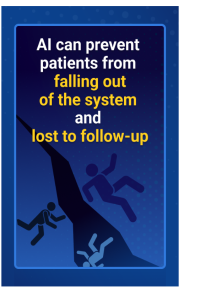Every year, too many people with health problems fall through the cracks of a complex care continuum. They go missing—poof—amounting to fewer patients on care plans than experts say should be. In turn, this drives a longer time-to-diagnosis, advanced disease progression and sometimes ED overutilization. But the losses are also an insidious hit for stakeholders, such as healthcare organizations, healthcare providers and yes: pharma, too.
Take hypertrophic cardiomyopathy (HCM), a heart thickening that cardiologist Ronald Wharton, MD sees often in his practice. For every patient he evaluates, diagnoses and starts on once per day oral therapy, many more go undiagnosed.
“Based on literature, there’s a probable HCM prevalence as great as one in 250 people,” said Dr. Wharton, cardiologist at Northwell Health. “That’s a lot. But the claims indicate that we’re probably missing 80% of patients. Not nearly enough people are diagnosed as the statistics tell us should be.”
What happens to patients who have gone missing? Do those underdiagnoses mean there are fewer ‘would-be’ scripts for newer therapeutic agents such as oral cardiac myosin inhibitors? Perhaps so.
But, even if people do get a diagnosis—HCM or otherwise—or at least a specialist referral, the onus often falls on the patient to maintain their care, which invites more attrition. One study pinned the lost to follow-up rate at 22.3%.
When care plans are abandoned, drug companies absorb the opportunity costs. And those can add up, suggests Philip Batista, MD. Having seen the effects of patient no-shows in his vascular practice, he says loss to follow-up is a significant concern.
“Today, I had 26 patients scheduled and about five didn’t show,” said Dr. Batista, vascular and endovascular surgeon with Cooper University Health Care. “And we’re dealing with conditions that require routine surveillance, like peripheral artery disease and aneurysms. We have to manage these patients longitudinally, so following up is vital in their care.”
Fortunately, recent advancements across clinical artificial intelligence (AI) tools could help stem the losses from underdiagnoses and missed follow-ups. With custom-built, manufacturer-sponsored algorithms integrated into clinical workflows, pharma companies have realized new promises in automated alerting. This can help salvage patients who’d otherwise fall through the cracks.
Not only is that helping find new patients and improving pharma’s bottom line, it’s also, more importantly, improving care pathways.
The case for clinical AI
Clinical AI tools have advanced mightily, with a new generation of decision support that can alert physicians when patterns across electronic health records (EHRs), imaging or other inputs indicate something may be wrong.
Some platforms, like Viz.ai’s, integrate alerting directly into workflows so that next best actions can unfold at the point of care. For example, if the algorithm suggests to a clinician that a patient might have a certain diagnosis, the system has a built-in way for them to easily view or order labs, imaging, medications or whatever else may be necessary. Providers can then get going immediately, without patients having to follow-up and wait.
Automated decision support across TA

The use cases for AI alerts and care coordination span the gamut. As one example, a recently FDA-approved algorithm helped cardiologists establish an HCM diagnosis for a 74-year-old patient within months—after she went undiagnosed for 10 years. In that case, app-based care coordination features helped match the patient to the right cardiology specialists to evaluate the echocardiogram and make the diagnosis.
“We have many patients who we can monitor and evaluate directly using AI,” he said. “From there, we can then have nurse managers and others assist us with the workflow necessary for surveillance. In this way, we’re utilizing the system to identify patients who would otherwise fall through the cracks.”
New opportunities for pharma marketing
Alerting platforms are increasingly on the radar of pharma marketers, who work with partners like Viz.ai to develop the algorithms and workflows to get patients to the right specialists. The ROI is in market development: The more patients get diagnosed, the more therapies get prescribed.
Even so, organizations looking to embrace point-of-care AI may need to break through silos between marketing, medical affairs and other departments. These innovations aren’t necessarily owned by marketing or medical, but by everyone. And they stand to benefit everyone, too.
“It’s a matter of good patient care,” said Dr. Wharton. “Using technology to help patients is not something that’s new with the advent of artificial intelligence, but it is the latest chapter in it. And I see a lot of promise ahead.”